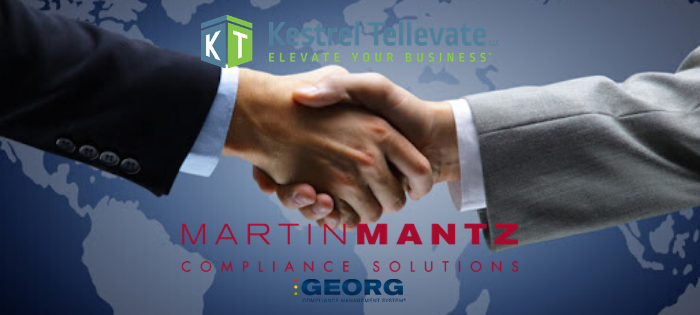
Taking Training Virtual…Or Not
Over the past several months, many companies have had to prioritize business activities given restrictions on travel and social distancing guidelines. Despite these restrictions, however, certain compliance activities are still required, including training.
Training is a key component for maintaining ongoing compliance—whether with regulatory requirements, supply chain mandates, or internal policies. While some training can be postponed, putting training on the backburner can have its consequences, ranging from unprepared employees, to noncompliance, to preventable injuries or worse.
Much like with audits, there are alternatives to meeting training requirements and ensuring employees are well-instructed and prepared to do their jobs, even with current government and/or company restrictions. Online and virtual training are not necessarily new options, but their popularity is most certainly on the rise. In-person, online, and virtual training can all provide quality options if you understand your training needs and understand what type of training works best in different scenarios.
Face-to-Face
As we have experienced, sometimes there is no substitute for doing things face-to-face. For certain types of training, in-person is clearly the best alternative for a number of reasons:
- It is designed for people who need to genuinely know the material inside and out and for those who would benefit from a more tailored, interactive learning experience.
- With in-person training, learners are able to ask specific questions and get them answered immediately.
- In-person training provides a focused, immersive learning experience, where attendees can have interaction, discussion, and live input.
- Trainers get to know attendees and can adjust training (e.g., material, learning speed, examples) to the group’s learning style.
- In-person training allows attendees to develop relationships with the trainer and other attendees, which can prove beneficial on future projects.
As many organizations have discovered, particularly lately, while in-person training may offer a great alternative, it is not always possible. Beyond travel and social distancing restrictions, in-person training can also be cost-prohibitive. In addition, scheduling of in-person training can present more challenges, as timing is based on the instructor and is not flexible.
Best suited for: Multi-day classes where demonstration of competency is needed, and participants are building skills they will use frequently; introductory classes where participants need to understand new material.
The Online Option
At the other end of the spectrum, we have online training (not to be confused with virtual, which is discussed below). Online training involves an online module that allows participants to watch and/or listen to a pre-recorded class. Generally speaking, online training works best when individuals already know the material (e.g., refresher training) and is most appropriate when the attendee does not have to be an expert in the subject matter (i.e., awareness level vs. functional expertise).
In addition, online training is generally cheaper since it is not customized and does not require travel or an onsite trainer. It can also be faster and more flexible, as attendees can work at their own pace and have the ability to pick their own schedule.
While there are certain benefits to online training, it is not suitable for all types of training. Because online training does not involve a live instructor, attendees are generally unable to ask questions effectively and there is little opportunity for follow-up input on areas covered. This is no opportunity for hands-on learning and interaction. For example, something like 24-hour HAZWOPER training would be difficult to do as an online course, as a hands-on component is valuable in helping participants demonstrate competency, as required. Finally, because of a potentially diverse audience, online training tends to be generic and not tailored to the specific needs.
Best suited for: Courses where participants have had many, many years of experience and just need refreshers, such as HAZWOPER 8-hour, DOT General Awareness, or RCRA refresher training.
Taking It Virtual
Finally, virtual training provides a bridge between online and in-person training. Like online training, virtual training is done via technology (e.g., Zoom, WebEx); however, it takes place live with instructors engaged in the training as it is occurring. Virtual has many of the same advantages as in-person training since it is being done live. Learners can get more in-depth training and benefit from live interaction, questions, and discussion to help develop specialized expertise. Virtual training works best when travel is limited but students still need to have real-time input from the instructor.
That being said, virtual training cannot completely replace in-person training. With screens, it may be difficult for the trainer to read the crowd and accurately interpret learning needs. Hands-on opportunities become more limited—though not impossible—and require cooperation, coordination, and open-mindedness from all attendees. Finally, technology and logistics are critical for this type of training. A computer with good internet access is critical. If internet connections are slow or sound quality is poor, training can quickly become ineffective.
Best suited for: Refresher training (as with online options), more detailed training that can be customized to the specifics of the class (i.e., site-specific, industry-specific), or training for those with less experience who may need to ask questions.
Consider Learning Styles
People learn very differently. Some people are aural learners and can hear material and develop understanding. Others are visual learners so just reading material on a screen “sticks.” Others are tactile learners and need to participate in physical interaction to understand content. It is important to keep this in mind when choosing the best platform, as well:
- With in-person classes, all learner types can be addressed.
- With online classes, typically only visual learners retain the information unless there is audible training coordinated with the material.
- With virtual learning and coordination with the site prior to the training program, all three learner types can be addressed.
While some training can be rescheduled with minimal impacts to the business, many training requirements cannot. Companies need to know their workers are retaining the information, particularly given OSHA requirements that employees must demonstrate understanding and competency. To ensure that training not only “checks the box” but is also effective, it is important to evaluate not just the training, but the delivery options. In-person, online, and virtual all have their strengths based on the training needs and individual learning styles.

Gathering and Leveraging Data
Checklists are a common way to collect information. From inspections and maintenance checks to near-miss and behavior-based safety reporting, most companies regularly use some form of checklist to gather information that should help inform operational decisions. Checklists are important. They establish good employee practices for regularly reviewing operational areas. But the information gathered in checklists only adds value to the organization if the data collected is used.
What happens to your checklists once they are filled out? Are they submitted? Is the data reviewed? And importantly, how are you leveraging the data gathered to better understand and improve your organization
Gathering Data
There are dozens of options available for gathering data through checklists. Paper checklists are largely becoming a thing of the past—and for good reason. Mobile forms and technology (e.g., Microsoft Forms, Google Forms) make completing checklists of almost any type easier and faster in the field. Mobile forms allow employees to quickly and easily complete forms from a mobile device—without logging in—from daily inspections to near-miss information as it is happening. Any daily, weekly, monthly form/checklist can be turned into a mobile form (e.g., Powered Industrial Truck inspection checklists, monthly tank inspection checklists, incident reports, non-conformance reports). Questions can be multiple choice, yes/no, text, numerical, rating scales, and several others.
Storing Data
Not only is completing an electronic form easy for employees, one of the largest benefits of gathering data via a mobile checklist is that the resulting data is already in digital format—and much more usable than a binder filled with paper checklists.
Checklists can be designed to move the data gathered from the form directly into a database, such as Microsoft SharePoint or a SQL database. Digital data from all electronic forms can then be stored in a centralized system; categorized for searchability; and easily accessed for review, comparison, and analysis.
Displaying Data
With all data that is collected being stored in a central database, it then becomes possible to leverage and manipulate that data to graphically display high-level information on a dashboard through the use of technology like Microsoft Power BI. Google dashboards offer another user-friendly alternative for analyzing the resulting data. Dashboards serve as a user interface to display/highlight key information. When companies amass a lot of data in many different areas, the dashboard can provide an integrated view of data pulled from multiple checklists/modules in an easy-to-read display. Dashboards such as this:
- Provide greater visibility and alert to issues that need attention/resolution across the entire organization.
- Allow management to view outstanding issues under their responsibility.
- Display up-to-date graphics of how the organization is performing compared to goals.
- Generate graphs and charts from the data collected based on what information needs to be reported.
- Allow for the use of advanced data analytics to help identify patterns and trends, inform business decisions, and guide resources.
Many companies have a lot of great data at their fingertips but knowing to how access and leverage it can be a challenge. Checklists and forms provide a relatively simple and straightforward method for gathering electronic data and turning it into valuable information that can improve operations and help inform business decision-making.

Environment / Kestrel Tellevate News / Safety / Technology Enabled Business Solutions
Comments: No Comments
KTL Renews Agreement to Provide Access to EHS Regulatory Question Modules
KTL is pleased to announce that we have renewed our agreement with the Construction Engineering Research Laboratory (CERL) of the U.S. Army Corp of Engineers, which provides access to the following regulatory question modules:
- The Environmental Assessment and Management (TEAM) Guide and the related state supplements address environmental compliance in the areas of air quality, cultural and natural resources, hazardous materials and waste, pesticide management, pollution prevention, energy conservation, petroleum, oils and lubricants, storage tanks, solid waste management, toxic substances, water quality, and more.
- The Occupational Safety and Health (OSH) Guide is used in assessing compliance with the standards of the Occupational Safety and Health Administration (OSHA). It may also be used in combination with an agency-specific safety and occupational health manual. The OSH Guide is based on OSHA regulations from Title 29 of the Code of Federal Regulations.
KTL originally entered into this agreement with CERL in 2015. CERL’s experts are dedicated to conducting ongoing research, updating federal and state environmental and federal safety regulatory requirements, and developing and maintaining standardized audit checklists for those regulations. These checklists are very comprehensive; are used by auditors for DOD, DOE, DOI, and other federal agencies; are updated regularly to reflect any regulatory changes; and cover virtually all of the functions that would be present in a broad mix of industrial companies.
Our agreement allows KTL to make the TEAM Guide and OSH Guide available through an electronic format (i.e. dynaQ™). KTL staff can use these modules to stay current on changing federal regulations. The question modules bring a basis of significant credibility related to the reliability and completeness of audit content via a software tool that manages audit data and makes finding information more efficient. With this agreement, KTL remains one of the only professional service firms in the country to offer access to the following regulatory question modules.
Managing Projects & Permits
How many permits does your operating system (e.g., facilities, production, storage, transportation, distribution) have? What kinds of requirements are associated with each of those permits? Who is responsible for making sure requirements are fulfilled? Are there key/critical dates? How many contractors/vendors do you have carrying out activities pertaining to the many diverse permit requirements? How do you manage all that information? And, importantly, how do you verify compliance?
Depending on the breadth and locations of your operations, managing permits and their associated requirements and due dates without a centralized system in place can be an insurmountable challenge. This was certainly true for a large transportation company managing over 3,600 permits for over 1,600 projects across more than 20 states. Finding a better way to track and manage permits wasn’t just a matter of convenience, it was a necessity.
Web-based Tracking System
After a series of washout incidents, the company’s Engineering Department stepped up its efforts to develop a program to ensure engineering and maintenance activities were meeting applicable construction and environmental permit requirements. With so many activities, responsible parties, and deadlines, the Department retained Kestrel Tellevate LLC (KTL) to develop a web-based project tracking system to help:
- Track permit requirements and construction restriction timeframes
- Produce project-specific All Permits Issued (API) documents
- Track post-activity mitigation requirements
- Manage change information
- Report actual-to-budget performance
While the Engineering Department remains responsible for the permitting activities associated with all construction, maintenance, and emergency response activities, KTL’s Permit Tracking System (PTS) offers a cloud-based project management solution to facilitate permit tracking across a variety of data points.
How It Works
The PTS serves as a communication conduit by providing a standardized approach to project/permit activity tracking, while distributing periodic, tailored reports that allow the Engineering Department to manage project activities, as needed. Integrating with internal databases, PTS provides a means to supplement project data with ongoing contractor/consultant input. This enables comprehensive program oversight on the timeliness of the permitting effort and project details, which, in turn, offers preemptive visibility on issues that may affect project construction and permit compliance.
In short, PTS allows the company to:
- Catalog and track permits in one database
- Document and track project conditions, impacts, construction timeframe restrictions, sensitive resources, etc.
- Send and receive notifications of permits about to expire
- Coordinate and communicate with project contractors
- Establish accountability and a standardized approach for reporting and performance measurement
- Effectively manage project process from permitting through handover to construction
- Monitor financial performance
Business Benefits
The Engineering Department has managed nearly 1,600 projects with more than 3,600 associated permits through PTS. Permits in the system include 404 (most common), 401, Floodplain, NESHAPS, FAA, 402, Air, Coast, Air Emissions, 408 Levee, Coast Guard Bridge, Heritage Tree, Tank, Well, Excavated Materials, NPDES, and others.
With this many projects and permits being managed through a consolidated system, PTS is providing many business benefits, including the following:
- Improved program efficiency, consistency, and coherence by fostering a standardized approach to all permitting data management and input by third-party users
- Customized, automated reporting that allows for enhanced progress monitoring, project accountability, and detailed oversight
- Flexible, cloud-based approach to accommodate a variety of program management aspects into a single tool for real-time, comprehensive visibility
- Sole repository for all project management data to help foster communication and coordination both internally and with contractors/consultants
- Improved permit compliance assurance reliability

April 16 Webinar: Improving EHS Management with IT
Effective information management is critical to complying with complex EHS regulations. Join KTL and Southeast Missouri State University (SEMO) for this APPA webinar to get helpful tips for the successful management of EHS information, data, documents, and records.
Improving EHS Management with Information Technology: A University Demonstration
April 16, 2020 | Noon – 1:00 p.m. CT
REGISTER NOW!
This webinar will use a formal EHS management system model (plan-do-check-act) to highlight the importance of:
- Identifying, understanding, and documenting applicable EHS requirements
- Providing easy-to-use EHS information management tools
- Capturing institutional knowledge of experienced staff for operational sustainability
Learning Objectives
Facility managers, plant operators, EHS staff, and supervisors working in higher education will better understand:
- Key components of an effective EHS management system based on ISO 14001/45001
- Best practices for applying information technology to assist with EHS compliance
- Strategies for improving adoption of new technology tools throughout campus
- How to use an affordable, available technology platform (Microsoft SharePoint®) to enhance EHS compliance and communication practices
Presenters
SEMO’s Autumn Gentry will join KTL Principal Joseph Tell to provide a demonstration of SEMO’s recent efforts to manage and communicate EHS information using Microsoft SharePoint® tools to simplify EHS compliance.
About APPA, Leadership in Educational Facilities
Formerly known as the Association of Physical Plant Administrators, APPA is recognized globally as a leader in professional development programs, credentialing, research, publications, networking, and information services for the educational facilities profession. APPA’s mission is to “support educational excellence with quality leadership and professional management through education, research and recognition.”

Comments: No Comments
KTL Announces Partnership with German Company Martin Mantz
KTL is pleased to announce our partnership with Martin Mantz Compliance Solutions (Martin Mantz), developer of the GEORG Compliance Management System® software. KTL is providing regulatory compliance expertise to the German-based company as it expands its offerings to clients with operations in the United States.
“Martin Mantz has created something unique with the GEORG software in that it simplifies and provides an interpretation of legal and technical requirements in a customer-specific database,” KTL Principal Lisa Langdon states. “KTL’s understanding of industrial operations, as well as U.S. legal and technical requirements (e.g., EPA, OSHA, FDA, ISO), allows us to translate these requirements into simple tasks in the GEORG system that employees can follow to help fulfill regulatory requirements.”
How GEORG Works
GEORG is used to make the requirements of standards and regulations comprehensible and transparent. KTL specializes in the practical mapping of legal requirements and audits. These audits allow KTL to create technical content for the GEORG system based on facility-specific applicability. We then work directly with the company to delegate the identified tasks. If there are revisions in the standards/regulations, KTL works in the system to ensure tasks are updated to meet regulatory requirements.
The benefits of this approach include:
- Effectiveness – All tasks are assigned, easily formulated, and regularly updated.
- Efficiency – The effort and expertise required to understand complicated regulations is reduced.
- Transparency – Responsibilities are clear and easily visible to all employees.
- Conformity – Compliance status within the system reflects the degree of fulfilment of the related requirements.
Faber-Castell Expands GEORG Implementation to U.S. Subsidiary
Faber-Castell Cosmetics, an internationally renowned Martin Mantz customer with worldwide operations, is already benefitting from the Martin Mantz-KTL partnership. After successful implementation of the GEORG software in their German facilities, Martin Mantz has worked with KTL to expand usage to Faber-Castell’s subsidiary in the U.S.
About Martin Mantz Compliance Solutions
Martin Mantz Compliance Solutions, based in Grosswallstadt and Leipzig, Germany, offers its contractual partners services in the area of legal organization (GEORG) of companies to avoid organizational negligence and compliance violations. This includes consulting and provision of the compliance software GEORG Compliance Management System®, implementation of the technical and legal modules, as well as construction and maintenance of the customer-specific database. https://www.martin-mantz.de/
About Kestrel Tellevate LLC
KTL is a multidisciplinary consulting firm that specializes in providing environmental, health, and safety (EHS) and food safety management and compliance consulting services to private and government clients. Our primary focus is to build strong, long-term client partnerships and provide tailored solutions to address regulatory requirements. KTL’s services include management system development and implementation, auditing and assessments, regulatory compliance assistance, information management solutions, and training. KTL is a Small Business Administration-registered company with headquarters in Madison, WI and Atlanta, GA and offices across the Midwest and Washington, D.C. www.kestreltellevate.com

How Do I Efficiently Sustain Waste Management Compliance?
Understanding your waste requirements and then getting your facility in compliance with those requirements are important steps in your waste management efforts. However, effective waste management is not a one-time effort. It takes ongoing resources and tools to sustain ongoing compliance. Consider the following:
- How do you track your waste inventory?
- Do you have ongoing permitting requirements to manage?
- Does your staff need periodic training?
- Are there regular (e.g., annual, semi-annual) plans and/or reports you need to submit?
- Do you have routine inspections and monitoring?
- How do you maintain your records? Where do you house your documentation?
Managing all these things and effectively resourcing ongoing regulatory compliance needs can quickly become overwhelming—especially for those companies without a dedicated team of full-time environmental, health and safety (EHS) staff.
Technology Tools
Documenting waste management procedures and processes, along with management oversight and continual review and improvement, is key to ensuring ongoing compliance. Technology (i.e., a compliance information management system (IMS), apps, tools) can help create process standardization, operational efficiencies, and, subsequently, consistent and reliable compliance/waste management performance.
However, it must be noted that applying technology to operations isn’t about just finding and buying a software tool. It is about:
- Understanding the business need;
- Customizing and integrating the appropriate tool into existing operations; and
- Deploying it so it is effectively applied.
Scalable Solutions
Virtually every regulatory program, including those related to waste management, has compliance requirements that call for companies to fulfill a number of common compliance activities. While they do not necessarily need to be addressed all at once or from the start, considering the eight functions of compliance when designing compliance efficiency tools helps define the starting point and build a vision for the end result.
Compliance efficiency tools built on an Office 365 platform offer an adaptable/scalable solution that can allow you to more efficiently manage compliance tasks, corrective and preventive actions (CAPAs), and other project activities to ensure you are meeting your compliance requirements. Translating these common compliance functions into modules that can be instrumental in establishing or improving a company’s capability to comply, including:
- Facility profiles
- Waste inventories
- Compliance calendars
- Assessments & inspections
- Mobile forms & checklists
- Audit tracking
- Permit management/tracking
- Document and records management
Adding Business Value
In the end, implementing compliance efficiency tools such as this can provide the resources needed to effectively manage your waste management program—plus a number of other lasting benefits to the overall business:
- Helps improve the company’s capability to comply on an ongoing basis
- Establishes compliance practices
- Creates a strong foundation for internal and 3rd-party compliance audits and for answering outside auditors’ questions (agencies, customers, certifying bodies)
- Helps companies know where to look for continuous improvement
- Reduces surprises and unnecessary spending on reactive compliance-related activities
- Informs management’s need to know
- Enhances confidence of others (e.g. regulators, shareholders/investors, insurers, customers), providing evidence of commitment, capability, reliability and consistency in the company’s waste management program

Top 8 Tips for Building a New Compliance IMS
- Inventory your existing systems – Identify how you are currently managing your compliance needs/requirements. What’s working well? What isn’t working? Do the systems work together? Do they all operate independently? This inventory should evaluate the following:
- Current systems and tools
- Status and functionality of existing processes
- Data sources and ability to pull information from various sources
- Organizational complexity
- Compliance status
- Existing management systems
- Determine your business drivers – Are you looking to save time? Create efficiencies? Reduce the number of resources required? Have better access to real-time information? Answer to senior management? Respond to regulatory requirements? These drivers will also drive the decisions you make when it comes to module development, dashboard design, reporting, and more.
- Understand the daily routine of the individuals using the system – Systems and modules should be built according to existing daily routines, when possible, and then implemented and rolled out in a way that encourages adoption. Having a solid understanding of routine tasks and activities will ensure that the system is built in a way that works for the individuals using it.
- Understand your compliance requirements – Do you have permitting requirements? Does your staff need training? How do you maintain your records? Are there regular (e.g., annual, semi-annual) plans and/or reports you need to submit? Do you have routine inspections and monitoring? All of these things can and should be built into a compliance IMS so they can be managed more efficiently.
- Get the right parties involved – There are many people that touch a compliance IMS at various points in the process. The system must be designed with all of these users in mind: the end user entering data in the field, management who is reading reports and metrics, system administrator, etc. A truly user-friendly system will be something that meets the needs of all parties. If employees are frustrated by lack of understanding, if the system isn’t intuitive enough, if it is hard to put data in or get metrics out, the system will hold little value.
- Make your wish list – While you may start your project one module at a time, it is important to define your ultimate desired end state. In a perfect world, how would the system operate? What parts and components would it have? How would things work together? What type of interfaces would users have?
- Set your priorities, budget, and pace – What is the most important item on your list? Do you want to develop modules one at a time or as a fully functional system? It often makes sense to start where you already have processes in place that can be more easily transitioned into a new system to encourage user buy-in. Priorities should be set based on ease of implementation, compliance risk, business improvement, and value to your company.
- Select the right consultant – For a compliance IMS, it is valuable to have a consultant who doesn’t just understand technology but also understands your operational needs, regulatory obligations, and compliance issues. An off-the-shelf software solution isn’t a silver bullet. A consultant who can understand the bigger picture of where you want to go and will collaborate to design the right compliance IMS and efficiency tools will bring the most value to your organization.
- Understanding the bigger picture of where you want to go. We ensure your system is scalable and flexible; upfront planning enhances the outcome more efficiently.
- Collecting and organizing the information in a way that reflects how you conduct business and that aligns with other systems/processes.
- Offering guidance on compliance best practice and what modules and level of customization will bring you the most value.
- Providing as needed compliance support (e.g., review of existing forms and checklists, program improvement, development of training content, compliance audits, audit protocol).

Environment / Food Safety / Quality / Safety / Technology Enabled Business Solutions
Comments: No Comments
Technology & the 8 Functions of Compliance
Virtually every regulatory program—environmental, health & safety, security, food safety—has compliance requirements that call for companies to fulfill a number of common compliance activities. While they do not necessarily need to be addressed all at once or from the start, considering the eight functions of compliance (as outlined below) when designing a compliance Information Management System (IMS) helps define the starting point and build a vision for the “end point” when planning IMS improvements. These compliance functions translate into modules—facility profiles, employee counts, training tracking, corrective action tracking, auditing tasks, compliance calendars, documents and records management, permit tracking, etc.—that are instrumental in establishing or improving a company’s capability to comply.
8 Functions of Compliance
- Inventory means taking stock of what exists. The outcome of a compliance inventory is an operational and EHS profile of the company’s operations and sites. In essence, the inventory is the top filter that determines the applicability of regulatory requirements and guides compliance plans, programs, and activities. For compliance purposes, the inventory is quite extensive, including (but not limited to) the following:
- Activities and operations (i.e., what is done – raw material handling, storage, production processes, fueling, transportation, maintenance, facilities and equipment, etc.)
- Functional/operational roles and responsibilities (i.e., who does what, where, when)
- Emissions
- Wastes
- Hazardous materials
- Discharges (operational and stormwater-related)
- Safety practices
- Food safety practices
- Authorizations, permits & certifications provide a “license to construct, install, or operate.” Most companies are subject to authorizations/permits at the federal, state, and local levels. Common examples include air permits, operating permits, Title V permits, safe work permits, tank certifications, discharge permits, construction authorization. In addition, there may be required fire and building codes and operator certifications. Once the required authorizations, permits, and/or certifications are in place, some regulatory requirements lead companies to the preparation and updating of plans as associated steps.
- Plans are required by a number of regulations. These plans typically outline compliance tasks, responsibilities, reporting requirements, schedule, and best management practices to comply with the related permits. Common compliance-related plans may include SPCC, SWPPP, SWMP, contingency, food safety management, and security plans.
- Training supports the permits and plans that are in place. It is crucial to train employees to follow the requirements so they can effectively execute their responsibilities and protect themselves, company assets and communities. Training should cover operations, safety, security, environment, and food safety aimed at compliance with regulatory requirements and company standards and procedures.
- Practices in place involve doing what is required to follow the terms of the permits, related plans and regulations. These are the day-to-day actions (regulatory, best management practices, planned procedures, SOPs, and work instructions) that are essential for following the required processes.
- Monitoring & inspections provide compliance checks to ensure locations and operations are functioning within the required limits/parameters and the company is achieving operational effectiveness and performance expectations. This step may include some physical monitoring, sampling, and testing (e.g., emissions, wastewater). There are also certain regulatory compliance requirements for the frequency and types of inspections that must be conducted (e.g., forklift, tanks, secondary containment, outfalls). Beyond regulatory requirements, many companies have internal monitoring/inspection requirements for things like housekeeping, sanitation, and process efficiency.
- Records provide documentation of what has been done related to compliance—current inventories, plans, training, inspections, and monitoring required for a given compliance program. Each program typically has recordkeeping, records maintenance, and retention requirements specified by type. Having a good records management system is essential for maintaining the vast number of documents required by regulations, particularly since some, like OSHA, have retention cycles for as long as 30 years.
- Reports are a product of the above compliance functions. Reports from ongoing implementation of compliance activities often are required to be filed with regulatory agencies on a regular basis (e.g., monthly, quarterly, semi-annually, annually), depending on the regulation. Reports also may be required when there is an incident, emergency, recall, or spill.
Reliable Compliance Performance
Documenting procedures on how to execute these eight functions, along with management oversight and continual review and improvement, are what eventually get integrated into an overarching management system (e.g., environmental, health & safety, food safety, security, quality). The compliance IMS helps create process standardization and, subsequently, consistent and reliable compliance performance.
In addition, completing and organizing/documenting these eight functions of compliance provides the following benefits:
- Helps improve the company’s capability to comply on an ongoing basis
- Establishes compliance practices for when an incident occurs
- Creates a strong foundation for internal and 3rd-party compliance audits and for answering outside auditors’ questions (agencies, customers, certifying bodies)
- Helps companies know where to look for continuous improvement
- Reduces surprises and unnecessary spending on reactive compliance-related activities
- Informs management’s need to know
- Enhances confidence of others (e.g. regulators, shareholders/investors, insurers, customers), providing evidence of commitment, capability, reliability and consistency in the company’s compliance program

Case Study: Integrated Compliance IMS
This is the next article in Kestrel’s series about Technology-Enabled Business Solutions.
What do you do when your company has multiple grandfathered-in systems that don’t talk to each other? How about when not all locations have access to the same systems…and you have over 150 locations and are still growing? What about when employees are spending excess time collecting and combining information manually instead of electronically? What if you can’t correlate data and generate reports because of multiple systems?
Cut Your Losses, Prioritize Your Needs
These things happen—probably more frequently than one might think. For one of Kestrel’s clients, a large chemical distribution company, all these things were happening simultaneously, and the cost to upgrade existing systems to respond to these needs was getting out of hand. How do you manage that? Do you just cut your losses and find a new compliance IMS solution? Do you address one issue at a time, or does that introduce the risk that everything won’t work together? Again.
Transitioning from one system to another—whether in part or completely—isn’t simple. It takes planning and forethought to create a scalable solution that can be adapted to the company’s overall needs. Proactively managing any sort of technology transition—including prioritizing needs and scheduling how quickly modules are developed and rolled out—is key.
From the beginning, Kestrel’s EHS and IT consultants worked to fully understand the company’s operations, existing systems and workflows, and desired outcomes of the overall system before recommending an approach. Without these upfront conversations, this company could’ve ended back in the same situation with a different system. Instead, they are on their way to developing a robust and scalable compliance IMS that can be adapted to the company’s overall needs and will eventually replace their off-the-shelf software.
Starting with the Data
Our client’s initial request was for dashboard reporting that would:
- Provide a visual of the Excel reports the company was pulling from multiple independent systems, and
- Create efficiencies in the data collection and reporting approach.
During initial conversations about the company’s compliance, information management, and overall business needs, it became clear to Kestrel that the existing facility database forms the foundation for the overall system. All content stems from this database. To create the efficiencies and dashboards the company wanted, building the facility database needed to happen first.
Facility information was originally tracked on individual Excel spreadsheets that were later combined to create a quarterly report. This very manual practice presented risks of user error in data entry, data manipulation, analysis, and reporting. Kestrel developed a facility database in SharePoint to serve as a centralized list, with detailed information on each location. Multiple other databases were then created that filter content into each facility page to create a simplified view of all items associated with each facility. Those other databases currently include:
- Employee counts
- Facility audits
- Sustainability reports
- List of storage tanks, with other assets to be added in the future
- Facility images
- Managed requirements
Let’s look at the employee database as one example of data that flows into the facility database. The employee database is used to track the number of employees in each location and each department. Information is filtered into the facility database, updating the employee count section. This employee database is also used to track access/permissions to the company site, look up individuals within other forms, and assign training based on job title.
The facility database now acts as the centralized core to the entire system. Information available here can be used to drive other actions and lists within the site, such as compliance tasks, corrective and preventive actions (CAPAs), inspections, near-misses, incidents, permitting requirements, etc.
Bringing in Forms
Where does all the data in those databases come from? That is where mobile forms and checklists enter the picture. Integrating various Office 365 technologies, Kestrel is creating several mobile forms, such as the near-miss app, to allow employees in the field to capture data electronically. The forms are accessible at multiple levels and can be assigned down to an individual location. Importantly, there is no need to log in to submit data, ensuring ease of access and use for all employees.
As employees complete the forms, data is collected and uploaded into the company’s related database(s) in real-time. All forms and databases are integrated. Not only does this eliminate the problems associated with manual data entry and manipulation, it provides real-time access to valuable data.
Compliance Dashboard
Kestrel has also created a login-driven compliance dashboard that houses key metrics, compliance tasks, and an at-a-glance compliance calendar. The dashboard can be customized for various applications based on the company’s needs as they continue to use the system—employees, management, departments, divisions, facilities, etc.
Currently, various compliance tasks (and associated reminders) are assigned to individuals throughout the 150+ locations. The dashboard filters assigned tasks to the individual logged in, so each employee can view his/her compliance-related tasks. At the same time, management can view outstanding issues that fall under their area(s) of responsibility, and the calendar provides a quick overview of compliance deadlines throughout the year.
The dashboard provides additional visibility for compliance tasks and alerts management to issues that need attention/resolution across the organization. It can also incorporate data analytics to help identify patterns and trends, inform business decisions, and guide resources.
Building for the Future
Now that the company has a solid foundation, work can commence to bring the independent systems into a single platform. Kestrel’s EHS team continues to identify additional compliance management needs, including checklists and mobile forms, internal audits, permit tracking, training tracking, safety meetings, mobile inspection/audit functionality, document control, incident reporting, and more. As these needs are identified, they can be built into the larger compliance IMS to create one integrated system going forward.
As Kestrel’s lead SharePoint Specialist Jaime Doty stated in a recent Q&A, “If you know where you want to end in an ideal world, it becomes a lot easier to find the starting point. It also makes creating a scalable system much more likely, because you are designing the system with the end in mind.”
This has ensured development of a system that:
- Is built from the perspective of the people who will be using them—in the field, in the plant, in the office, in the board room
- Integrates various databases and forms into a single, familiar platform
- Allows information to be shared and tracked in multiple ways
- Gives the ability to manage sites/facilities/plants/departments for compliance purposes
- Simplifies the data entry process by providing user-friendly functionality
- Provides for continual adaptation to meet future data management and reporting needs
That is exactly the forward-thinking perspective Kestrel takes on all projects—thinking beyond individual efficiency tools, considering the desired state, and determining how technology can make that happen. By coordinating technology and compliance expertise, Kestrel offers unique capabilities and perspective. Our EHS and food safety professionals understand the regulatory obligations, business needs, and needs of the users. This drives design and development of the right compliance IMS and efficiency tools—one that works within the company’s implementation timeline and budget—to reduce compliance risk, create operational efficiencies, and generate business improvement and value.
